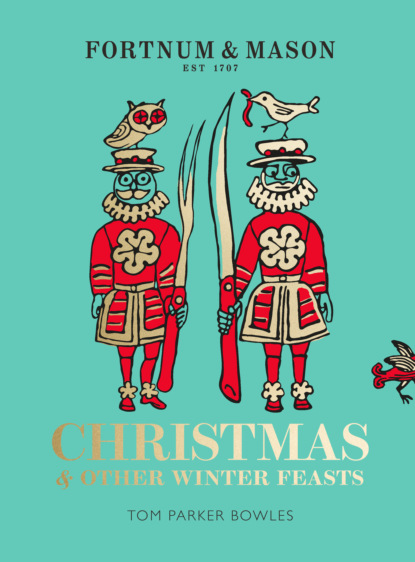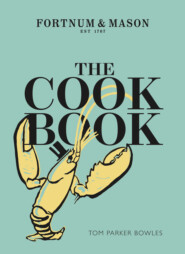По всем вопросам обращайтесь на: info@litportal.ru
(©) 2003-2024.
✖
Fortnum & Mason: Christmas & Other Winter Feasts
Настройки чтения
Размер шрифта
Высота строк
Поля
About the Author
About the Publisher
Edward Bawden (#uf59e83a6-8f18-5655-bfc9-3022b92f8108)
For many, Fortnum & Mason is all about the food. And rightly so. But back in the 1920s, it added another rather lovely string to an already elegant bow. Because it was then, among the cold, parsimonious monotony of post-war Britain, that a glorious burst of colour exploded throughout the relentless, gunmetal-grey gloom. In the form of the Fortnum’s Commentaries, lavishly illustrated, beautifully written booklets created by Colonel Charles Wyld, the legendary Fortnum’s managing director, in partnership with Hugh Stuart Menzies and Marcus Brumwell, whose advertising agency held the Fortnum’s account.
At heart, the Commentaries were direct mail catalogues, expressly designed to boost sales. But they were done in such style, with such wit and verve, both visual and written, that they far transcend their commercial roots. ‘I visualised little booklets,’ said Menzies a few years later, ‘sent to a carefully chosen mailing list; booklets as readable as something bought at a bookstall or drawn from the library. Every preconceived notion of a trade catalogue was to be violated. Space was to be sacrificed to pure fun in every direction …’ Their enduring appeal is testament to the brilliance of Wyld, Menzies and Brumwell.
And it is many of the pictures from the Commentaries that help illustrate this book. Artists such as Rex Whistler were contributors, and in 1932 Edward Bawden (now, at long last, being rightly revered) started working on a regular basis with Fortnum & Mason. Menzies, in addition to holding the store’s advertising account, was also in charge of the firm’s Invalid Department, a place where all manner of restorative broths and gentle blancmanges were sold to the well-heeled weak and poshly poorly. In the words of Robert Harling, ‘Bawden’s drawings were exactly attuned to Menzies’ almost carefree yet cunningly persuasive prose.’
The relationship continued until the late 1930s, when the war put a swift end to any advertising. Among many other things. Life in post-war Britain was, in many ways, harder, with increased rationing and a country crippled and on her knees. But with the end of rationing in 1955, the relationship with Fortnum’s resumed. Colonel Wyld was dead, Hugh Stuart Menzies would soon follow, and Fortnum’s had been bought by Garfield Weston, a Canadian multi-millionaire for whom the store became a hobby, and then a passion. The advertising firm was now Colman Prentis & Varley, managed by a friend of Bawden’s called Jack Beddington, who had worked with John Betjeman on Shell’s brilliant ‘Shell on the Road’ ads in the 1930s. Bawden now worked with Ruth Gill’s crisp and clean lettering, instead of Menzies’ witty prose, and the results are astounding.
As Mary Gowing wrote, ‘You have only to look at the impeccable yet lively and varied typography of the Fortnum & Mason catalogues (page after flawless page of it) to realise the demands that must have been made on the compositor. The colour, too, with its exciting juxtapositions of cool pinks and luminous scarlet, of blue greens, and green blues, must have been equally demanding of the printer.’
The first Christmas catalogue Bawden did for Weston was in 1955, and he produced some spectacular work each year until 1959. The 1958 catalogue is an extended pun on the word cat, and is full of witty and playful drawings – and one dog. Cats were a passion, and they strut and mewl, dance and grin their way through these remarkable works, along with chickens and sturgeon, elephants, ants and bees. His clean lines, bold colours and whimsical wit delight to this day. And will endure for generations to come.
Now, of course, Bawden is seen as one of Britain’s great painters, printers, illustrators and graphic designers. Part of his enduring appeal is his combination of modernism and tradition. He always believed that a good piece of design was as valuable as a painting (he was endearingly self-effacing and never took anything too seriously), and his work took in everything from iconic London Transport posters in the 30s, to film posters (‘The Titfield Thunderbolt’ being a particular favourite), illustrations for books (his pen and ink drawings for Ambrose Heath’s Good Food series are sublime), as well as book jackets, linocuts, wartime watercolours (from uniformed police officer to Ahwad Abdulla, son of Abudulla the coffee man), even wallpaper. He’s one of those artists you will have come across endlessly, without actually knowing it was him.
Bawden’s association with Fortnum’s was as fruitful as it is eternal. His illustrations have the same immediate appeal now as they did then. He not only learnt his trade at the store but managed to perfect it too. A marriage made in design heaven. Because at Fortnum & Mason, it’s never just about the food.
Introduction (#uf59e83a6-8f18-5655-bfc9-3022b92f8108)
Christmas at Fortnum’s. It’s the pure, 175-proof spirit of the festive season, the quintessence of Yuletide delight. ‘Is greediness a forgivable sin at Christmas time?’ gasped a smitten journalist, waxing lyrical about the store, some time towards the start of the twentieth century. ‘It ought to be, seeing how many well-nigh irresistible temptations one is exposed to at that delectable season.’
As a child, it was less shop, more glittering, spice-scented Xanadu, a sugar-coated stately pleasure dome. With the added advantage of being real, and sitting, ever-merrily, at 181 Piccadilly. Stepping into the shop, past the tail-coated doorman, was the nearest one could get to Willy Wonka’s chocolate factory. ‘At no time as now do the confectioners’ windows glisten with more enticing bait,’ sighed another scribe, in 1876. ‘Fortnum and Mason’s exhibition is enough to drive the whole race of children wild with delight.’
But this isn’t a book about childish delight, nor is it about Christmas alone. Not that we’d ignore the seasonal essentials, the likes of Norfolk turkey and York ham, porcelain pots of Stilton, sticky dates, smoked salmon, glorious griottes and Elvas plums. As if. Winter feasting, though, is at the book’s heart, feasting in its every guise. Once the nights draw in, and the temperature plummets, so the pleasures of the table, the age-old act of sitting down and breaking bread together, come to the fore. Food as succour, satisfaction, the great unifying force.
Keats rather nailed it (for a change) in ‘The Eve of St Agnes’, falling on 19 January: ‘… he forth from the closet brought a heap/Of candied apple, quince, and plum, and gourd;/With jellies soother than the creamy curd,/And lucent syrops, tinct with cinnamon;/Manna and dates, in argosy transferr’d/From Fez; and spiced dainties, every one,/From silken Samarcand to cedar’d Lebanon.’ A particularly Fortnum’s-esque feast.
We explode into Guy Fawkes night, with its fireworks, flaming anti-Papist pyres, pasties and caramelised apple pancakes, before gliding through the Somerset House ice rink, and SKATE!, with a cheese-drenched, Alpine-inspired smörgåsbord of Stilton fondue and tartiflette.
Game, that much under-rated British seasonal star, has its own section, with everything from braised venison pappardelle to pot-roast pheasant. There’s an entire chapter on Christmas baking, things to munch on Christmas Eve, and things to devour on Boxing Day, too. Leftovers are given the Fortnum’s treatment, from austere to revere. And the recipes take in both traditional and modern, much like the store itself. So there are Christmas spiced sausage rolls alongside scallop ceviche, roast goose next to gin and orange gravadlax.
It’s not all rich winter succour, either. January may be a time for a new start, and a rather lighter menu, but that doesn’t mean that flavour and joy have to be thrown out with the tree. At Fortnum’s, the first month of the year is about vibrant eating, delight without any of that ghastly guilt. Because this is a book entirely devoted to the pleasures of cooking and eating in the colder months, a volume that embraces influences British and international alike. Above all, though, this is about celebration. Of winter feasts and Christmas, rib-sticking tucker and salads both light and lithe. ‘Baby, it’s cold outside,’ crooned Dean Martin. All the more reason to stay inside and feast. Eat, drink, and be truly merry.
Ingredients (#uf59e83a6-8f18-5655-bfc9-3022b92f8108)
BURFORD BROWNS
Our eggs of choice. The yolks have a deep yellow hue, and are wonderfully creamy, too.
HONEY
Show me the honey. Every variety has its own taste and character, and at Fortnum’s we have not only a range of London honeys (produced in our own hives), but types from all over Britain and around the world.
BUTTER
We have some amazing butter at Fortnum’s, but one we particularly like is Abernethy butter, churned by hand in Ireland.
POTTED STILTON
A perennial Christmas essential, this classic English cheese is rich, creamy, with the most elegant of bites. And if it’s not produced in Leicestershire, Derby or Nottinghamshire, it isn’t the genuine article.
SMOKED SALMON
One of the great fridge fallbacks, this is another Yuletide star. Serve with scrambled eggs for an easy Boxing Day dinner, wedged into a fat sandwich, or simply as it is, with a squeeze of lemon and a liberal dose of black pepper.
GLENARM BEEF
This magnificent beef, produced in Northern Ireland, is sold exclusively at Fortnum’s in the UK. It’s aged in a Himalayan salt chamber, which intensifies the flavour, producing some of the finest beef you’ll ever taste.
SINGLE CASK MADEIRA
This fortified wine is one of the great unsung heroes of the drink world, with hints of caramel, walnut, raisin and coffee. It also has a fresh acidity that balances all that richness.
CAVIAR
For me, the ultimate edible treat – the salted eggs of the sturgeon fish. Eat it on top of baked potatoes, on homemade blinis or simply on its own, with the merest drizzle of lemon.
STEM GINGER
A wonder spice, ginger is said to help everything from morning sickness to muscle pain. It also tastes sublime, especially when kept in sugar syrup. Add to ice cream or crumbles, or simply eat on its own.
DOUBLE CREAM
Slather it over Christmas pudding, drizzle it into coffee, whisk it into thick peaks. No fridge is complete without double cream.
TIPS ON BUYING GAME
Trust your butcher, because they will know how old the bird is (important when it comes to buying grouse, as you want a young bird for roasting), and how long it’s been hung. If it stinks to high heaven, it’s been hung for too long.
Fireworks and Papist plots
Ah, Bonfire Night. The dazzling fireworks, burnished sausages, steaming paper cups of searing mulled wine. Children, crazed by cola, their eyes agleam with sugar and glee, their spirits as high as those rockets above. All centred on that roaring, crackling inferno, spilling warm light into the inky black gloom. So it seems a little incongruous that this merry night commemorates not the start of winter, nor some pagan feast, but rather the ritualised burning of a Papist plotter.
Which is, of course, the very reason for its existence – a celebration of the death of Guy Fawkes, who, along with his fellow conspirators, had planned to blow up King James I and the whole House of Lords.
Gunpowder Treason Day, as it was originally known, was actually a mandatory day of celebration, enforced by the introduction of the Observance of 5th November Act. But as ever in matters of the Protestant church, it quickly became a focal point for anti-Catholic abuse. While Puritans ranted and raved about the perils of popery, the common folk saw it as a time to rejoice, inspired more by the spirit of gin than that of the Lord. And, like the Christmases of old, festivities became increasingly drunken and raucous, with effigies of popular hate figures being burnt, including the Pope himself.
As time moved on, children would go begging with effigies of Guy Fawkes, a strictly seasonal money-making opportunity. Hence ‘a penny for the guy’. And so the 5th of November transformed into Guy Fawkes Night. By the nineteenth century, things were getting a little more violent, with confrontations mired in class hatred. ‘A chance,’ according to an 1850 article in Punch, ‘for the lower classes … to pit disorder against order, a pretext for violence and uncontrolled revelry.’ In Lewes, there was ‘lower class rioting’, and the intimidation of ‘respectable householders’, while in Guildford, ‘gangs of revellers who called themselves “guys” terrorised the local population’. Lewes still sets alight an effigy of Pope Paul V, an act of remembrance for the town’s seventeen Protestants burned at the stake during the sixteenth century. During this ‘close to the knuckle’ celebration, they also incinerate various villains du jour.
But for the rest of us, it’s the chance to wrap up warm, pray that the rain will hold off, and stare for hours into the flaming pyre. And at this chill, dark time of year, the sort of hearty, belly-sticking tucker that Fortnum’s sent out with intrepid climbers and explorers is exactly the sort of food one craves. Rich venison sausages, jacket potatoes stuffed with all manner of delights, and a very Fortnum’s take on the Cornish pasty … where the steak is replaced by game. ‘Fun food’, in the words of Hugh Ruttledge, that great Everest explorer, to lift the spirits and soothe the soul. Bonfire Night may have its roots in attempted regicide. But these days, it’s more about feasting. With a bang.
SPICY LENTIL AND CHESTNUT CASSEROLE WITH VENISON SAUSAGES (#ulink_3f29d398-aaa1-564b-9724-f395120b519b)
Venison sausages would be ideal, but don’t sweat too much if they’re difficult to find – any decent pork sausage will do fine. The key is to cook them slowly, over a low heat, turning them occasionally in a languorous manner. This could take up to 20 minutes, but the wait is well worth the bother.






